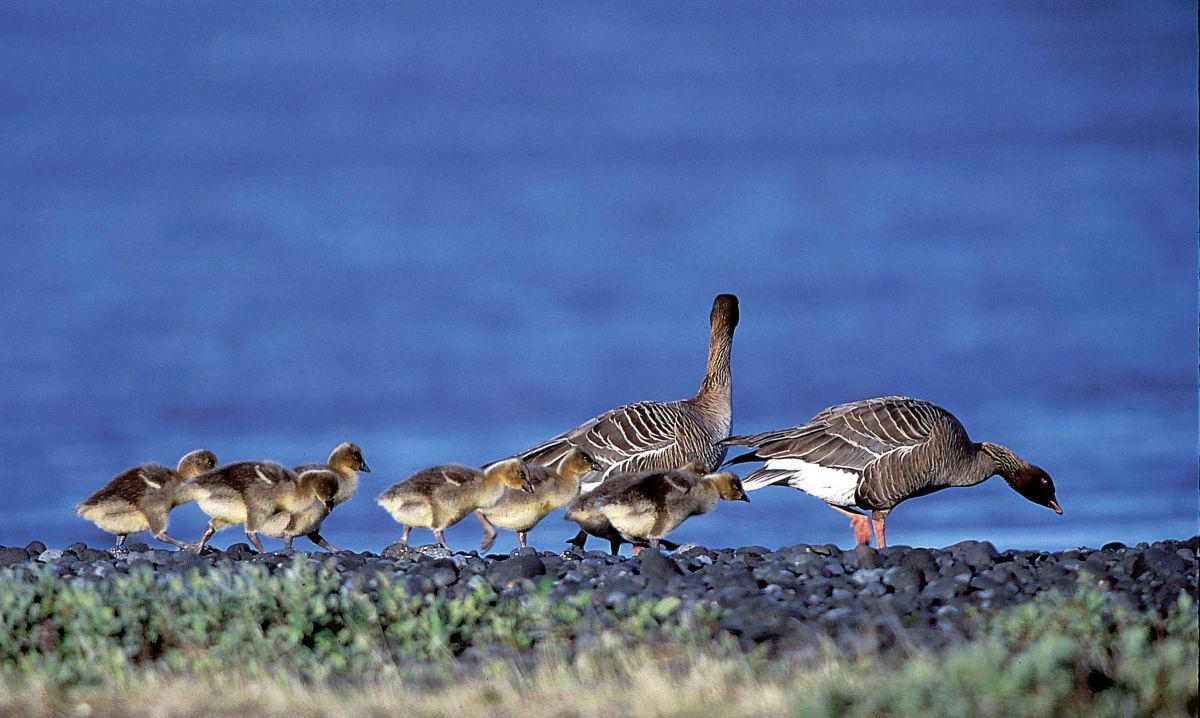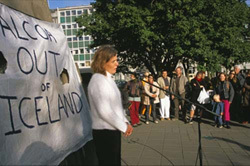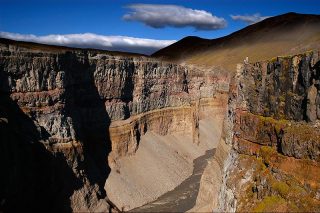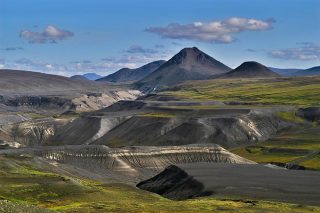'Impregilo'
Tag Archive
Aug 06 2004
ALCOA, Bechtel, Climate Change, Corruption, Democracy deficit, Ecology, Economics, Greenwash, Impregilo, Kárahnjúkar, Landsvirkjun, Laws, Pollution
Robert Jackson
So writes the poet and protester Elísabet Jökulsdóttir, and sitting in the board room of Landsvirkjun at a table long enough to hold a state banquet, it is hard to disagree with who is responsible for Kárahnjúkar. The walls of the ‘president’s floor’ have portraits of the men who in former times have managed the national power company. Read More
Aug 04 2004
ALCOA, Bechtel, Climate Change, Corruption, Democracy deficit, Ecology, Economics, Greenwash, Impregilo, Kárahnjúkar, Landsvirkjun, Laws, Pollution
Robert Jackson
It is now two years since the government gave the approvals that made way for the creation of a huge hydroelectric scheme in the Central Highlands at Kárahnjúkar. This paved the way for a subsequent deal with Alcoa for the building of an aluminium smelter in the coastal town of Reyðarfjörður.
WHAT DOES THE SCHEME INVOLVE?
The Kárahnjúkar project will consist of nine dams, three reservoirs, seven channels and sixteen tunnels. It will divert two large rivers, the Jökulsá á brú and Jökulsá í Fljótsdal, and several smaller rivers to the north of the Vatnajökull glacier, the largest glacier in Europe. The main dam will be highest rockfill dam in Europe, 190 metres high, 800 metres long and 600 metres wide at its base. This main dam will create a huge reservoir, to be called Hálslón, which will flood a wilderness area of 57 sq. km. 70 km of tunnels will carry water to an underground powerhouse, which will have a 690 megawatts capacity. Read More
Mar 21 2004
1 Comment
Actions, ALCOA, Barclays, Bechtel, Cultural, Democracy deficit, Impregilo, Kárahnjúkar, Landsvirkjun, Ólafur Páll Sigurdsson, Pollution, R & D Carbon, Repression, Saving Iceland
This historic action marks the beginning of Saving Iceland.
DON’T LET THE SUN GO DOWN ON ICELAND!
This was the message demonstrators at Tate Modern wanted to get across as Icelandic artist Olafur Eliasson’s hugely successful ‘Weather Project’ exhibition – featuring a giant sun – came to an end.
The 25 demonstrators staged an “umbrella protest” against the ALCOA dam currently under construction in the Icelandic highlands which will see vast swathes of Europe’s last remaining wilderness flooded in 2006.
Interviewed in the Guardian newspaper on the 27/12/03 Olafur Eliasson himself stated that his “greatest fear is that US aluminium giant ALCOA is destroying the Icelandic highlands with the support of our government.”
The Icelandic government recently announced further plans for similar projects which, protesters say, will spoil much of Iceland’s world-famous pristine nature.
“The government want to turn Iceland into a heavy industry hell,” said one protester, Icelandic environmentalist Olafur Pall Sigurdsson. “These mega projects benefit nobody except the multinational companies who instigate and build them. ”
“This programme of building big dams in Iceland will drag us back into the 20th century when the rest of 21st century Europe and the US is busy dismantling environmentally unfriendly dams,” Sigurdsson went on. Read More
Jan 01 2004
ALCOA, Amazon, Australia, Climate Change, Ecology, Economics, Impregilo, India, Kárahnjúkar, Landsvirkjun, Laws, Pollution, Repression, Surinam, WWF
‘Damned Nation’ is very good on the spiel behind the Karahnjukar project and Alcoa.
The Ecologist
v.33, n.10, 1. Jan 2004
Costing over $1 billion, the Karahnjukar hydroelectric dam in Iceland is a hugely controversial project. Mark Lynas journeyed to the blasting face, hoping to work out for himself whether this industrial elephant is green or brilliant-white.
 Reassurances in the Impregilo work camp canteen Read More
Reassurances in the Impregilo work camp canteen Read More
Nov 29 2003
8 Comments
ALCOA, Barclays, Bechtel, Corruption, Dams, Democracy deficit, Ecology, Economics, Greenwash, Guðmundur Páll Ólafsson, Impregilo, Kárahnjúkar, Landsvirkjun, Laws, Ólafur Páll Sigurdsson, Pollution, Repression, WWF
The Guardian, November 29, 2003
‘Power Driven’ appeared in The Guardian Weekend in 2003 and made a major impact in Iceland. It is still the best main stream analysis of many key issues at stake and an excellent overview of the social background.
In Iceland, work has already begun on a colossal $1bn dam which, when it opens in 2007, will cover a highland wilderness – and all to drive one US smelter. Environmentalists are furious, but the government appears determined to push through the project, whatever the cost. Susan DeMuth investigates.
North of Vatnajokull, Europe’s biggest glacier, lies Iceland’s most fascinating and varied volcanic landscape. Ice and boiling geothermal infernos meet at the edges of the glacier, and then the largest remaining pristine wilderness in western Europe begins – a vast panorama of wild rivers, waterfalls, brooding mountains and mossy highlands thick with flowers. Read More
Jun 02 2003
ALCOA, Dams, Democracy deficit, Ecology, Greenland, Greenwash, hydropower, Impregilo, Kárahnjúkar, Landsvirkjun, Laws, Pollution, Þjórsárver
Einar Þorleifsson and Jóhann Óli Hilmarsson
World Birdwatch vol. 25 no. 2, June 2003
As reported in the previous issue of World Birdwatch (25(1):7), a huge dam is being built in a remote part of Iceland to supply hydroelectric power for an aluminium smelter. The development is vigorously opposed by Fuglaverndunarfélag Íslands (Icelandic Society for the Protection of Birds, ISPB, Birdlife in Iceland). ISPB’s Einar Ó. Thorleifsson and Jóhann Óli Hilmarsson discuss the likely impacts on the unique wildlife and scenery of this pristine environment. Read More
Jan 15 2003
ALCOA, Denmark, Ecology, Greenland, Greenwash, Impregilo, Kárahnjúkar, Landsvirkjun, Laws, Þjórsárver

The proposed dams in Iceland are likely to completely destroy the nest sites of 1050-1350 pairs of Pink-footed Geese (equivalent to four per cent of the UK wintering population). In addition, thousands more are likely to be affected less directly by impacts such as the effects of hydrological changes on the birds.
Cambridge, UK, 15th January 2003
The Icelandic Government will put thousands of pairs of nesting Pink-footed Geese at risk by sanctioning two hydro-electric schemes, BirdLife International said today. Iceland has almost 90 per cent of the global population of this small goose, almost all of which winter in the UK, mainly in East Anglia and Scotland [1,2].
“BirdLife International estimates that as many as one in seven of the Pink-footed Geese that visit the UK in winter could be affected or displaced by these hydro-electric schemes”, said BirdLife Europe’s Conservation Manager, Szabolcs Nagy. “The two affected sites – Utherad and Thjarsarvar Important Bird Areas (IBAs) – are globally recognised, but Iceland seems determined to renege on its international conservation commitments and to damage and destroy substantial portions of these sites.” [3,4,5] Read More


